Salesfinity vs Orum vs Nooks – Who wins?
Discover why Salesfinity stands out among parallel dialers like Orum and Nooks. Learn how it empowers B2B SaaS SDR teams to maximize prospecting results through innovative features and compound prospecting strategies.

Article written by
Mavlonbek
Dear Sales Leader,
If you're tired of the relentless cycle of endless cold calls with minimal returns, buckle up. What you're about to uncover could ignite a seismic shift in your sales prospecting strategy—catapulting your results into the stratosphere.
Let's face it: In the high-octane world of B2B SaaS sales, every second counts. The pressure to hit quotas is intense, and traditional methods just aren't cutting it anymore. You need a tool that doesn't just keep up with the pace but sets it—a parallel dialer that propels your team to new heights.
Today, we're pitting Salesfinity, Orum, and Nooks against each other to determine which parallel dialer is the ultimate weapon for your sales arsenal. Spoiler alert: By the end of this deep dive, you'll discover why Salesfinity isn't just another dialer—it's the game-changer your team has been waiting for.
The Parallel Dialer Showdown: Analyzing the Titans of Prospecting
1. Dialing Dynamics: Beyond Mere Dials
The Problem with Conventional Parallel Dialing
Parallel dialing sounds like a dream—calling multiple prospects simultaneously to maximize connects. But here's the ugly truth: Traditional parallel dialers, like those offered by Orum and Nooks, dial up to five contacts at once and connect you with the first to pick up. The others? They get hung up on, often leading to frustrated prospects and spam flags from carriers.
Imagine this scenario repeating hundreds of times daily. Not only are you burning bridges with potential clients, but your numbers might get slapped with the dreaded "spam likely" tag. Ouch.
Salesfinity's SmartFlow: Dialing with Precision
Enter Salesfinity's SmartFlow. Instead of blindly blasting calls, SmartFlow intelligently scores contacts based on their likelihood to pick up. High-scoring contacts are dialed individually or with minimal parallel dialing, reducing hang-ups and ensuring more meaningful conversations.
This means:
Fewer Angry Prospects: By minimizing hang-ups, you're keeping potential clients happy.
Spam Avoidance: Reduced hang-ups mean carriers are less likely to flag your numbers.
Optimized Connect Rates: Speak to the right people at the right time.
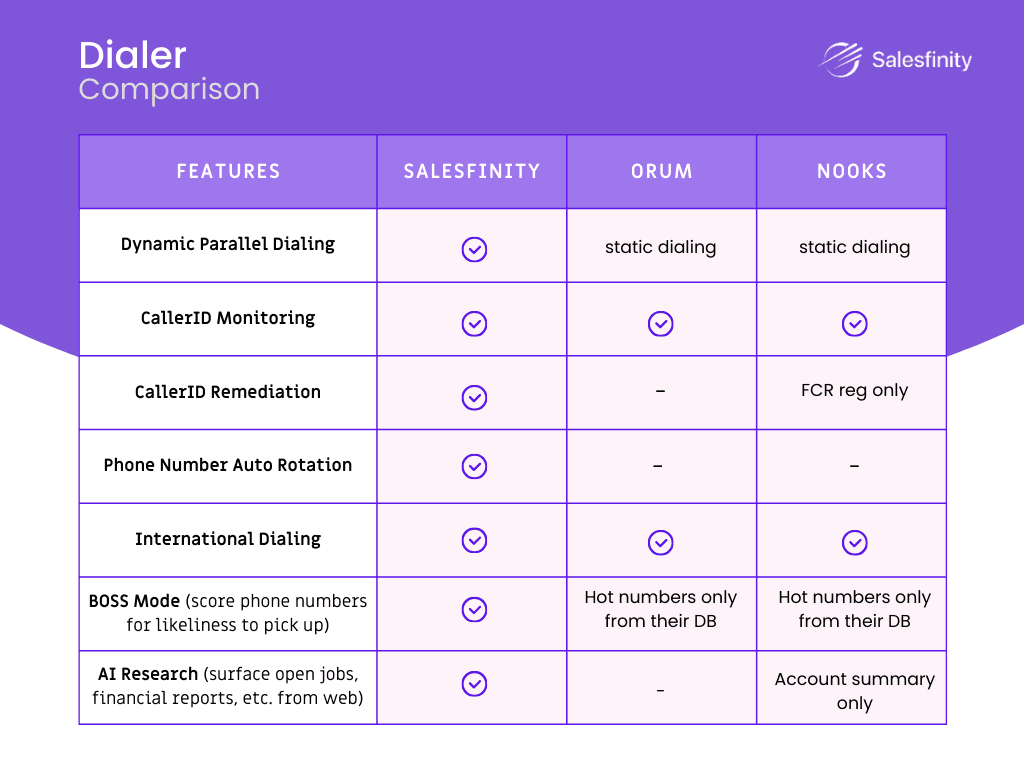
2. Integration Capabilities: Connecting Your Sales Ecosystem
While Orum and Nooks offer integrations with popular platforms like Salesforce, Salesloft, Outreach, Apollo, and HubSpot, their ecosystem is somewhat confined. For teams using other tools, this can mean manual data transfers and workflow disruptions.
Salesfinity's Expansive Integration Universe
Salesfinity breaks the mold with integrations spanning:
Salesloft
Salesforce
HubSpot
ActiveCampaign
Pipedrive
Monday.com CRM
And the crown jewel? An Open API that allows seamless integration with any system—including cutting-edge GTM solutions like Clay.com. Salesfinity ensures your tech stack is unified, streamlined, and supercharged.
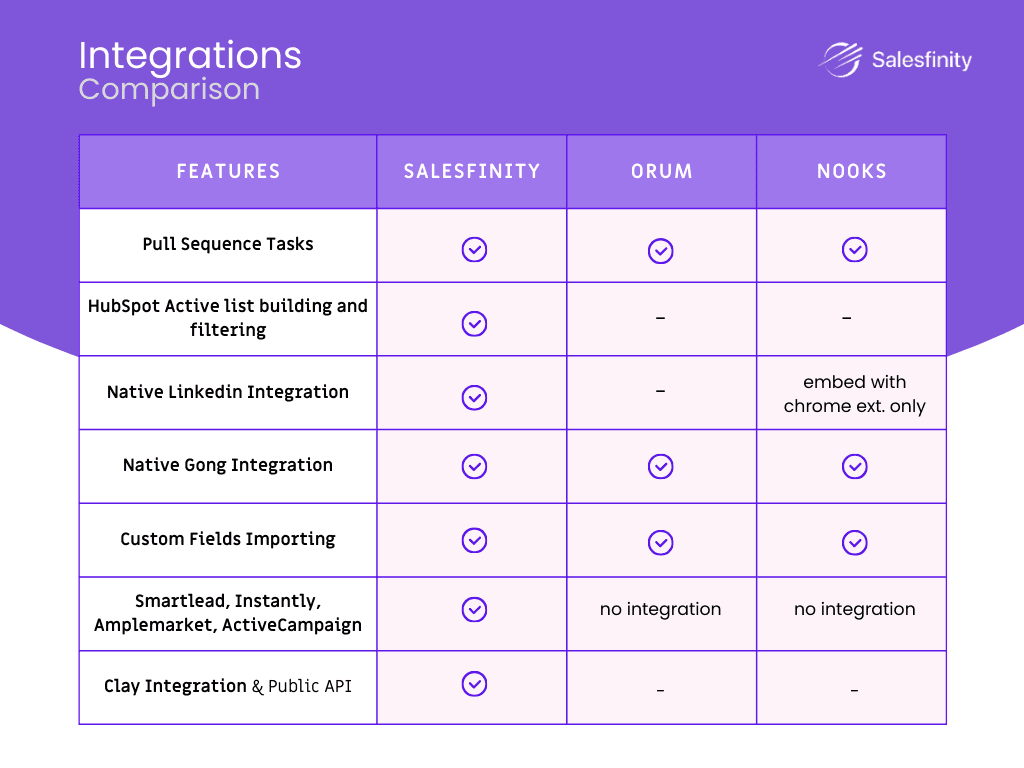
3. Advanced Reporting: Insights That Drive Performance
Robust Reporting Across the Board
All three contenders offer comprehensive reporting and analytics—tracking call volumes, rep performance, sequence breakdowns, and objection tagging. This data is crucial for refining strategies and boosting results.
Salesfinity's AI-Driven Objection Analysis
But Salesfinity takes it a step further. With sentence-level AI objection analysis, you gain laser-focused insights into:
Exact Objections: Understand precisely what prospects are pushing back on.
Rep Responses: See how your team handles objections in real-time.
Effectiveness Metrics: Identify which responses are turning objections into opportunities.
These insights empower your team to refine their approach continually, turning every "no" into a stepping stone toward "yes."

4. Data Enrichment: Fueling High Connect Rates
Orum and Nooks: Basic Enrichment Efforts
Orum: Offers alternative numbers if available in their database but doesn’t have partnerships with third-party data providers.
Nooks: Partners with Apollo, Datagma, Cognism, and integrates with ZoomInfo—if you have your own plan.
Salesfinity's Superior Waterfall Enrichment
Salesfinity boasts best-in-class waterfall phone enrichment with 6+ data providers, like:
Leadmagic
Prospeo
RocketReach
Wiza
The magic lies in Boss Mode—validating numbers before dialing to ensure accuracy. No more wasted calls on outdated or incorrect numbers. Just pure, targeted prospecting efficiency.
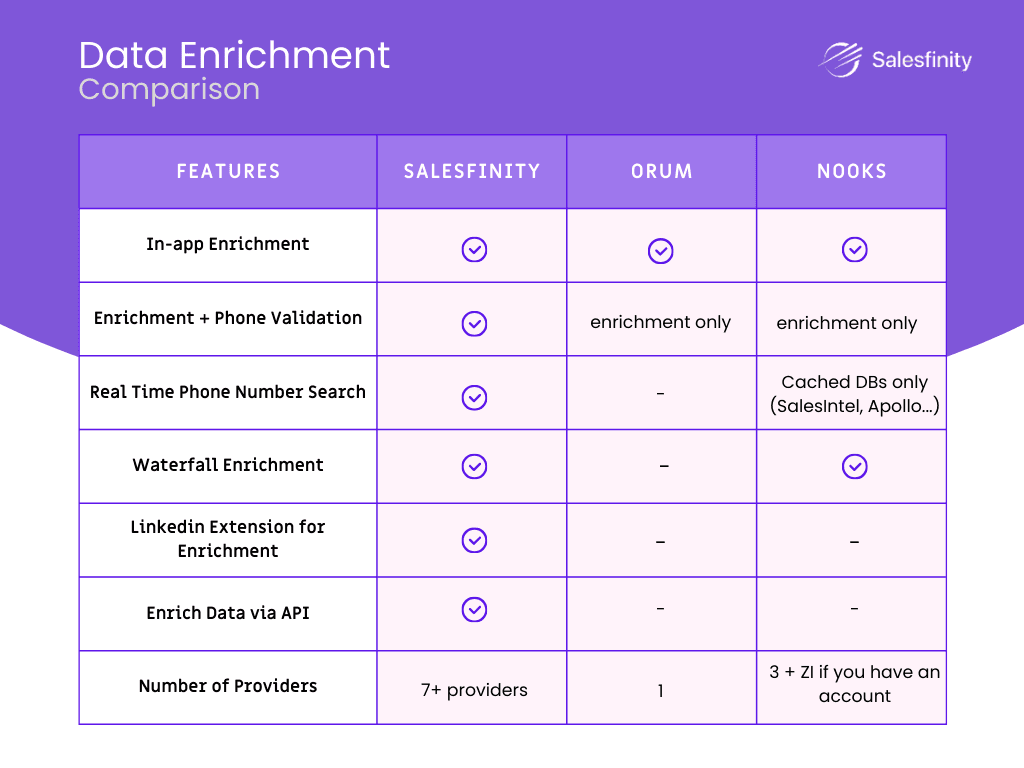
5. Follow-Up Automation: The Power of Compound Prospecting
Breaking Free from "Spray and Pray"
Most sales teams are stuck in a vicious cycle:
Build a massive list.
Blast messages via cold calls, emails, or LinkedIn.
Get minimal responses and move on to the next list.
This "spray and pray" approach lacks strategic follow-ups, doesn't compound over time, and leads to burnout and diminishing returns.
Salesfinity's Nurture AI: Transforming Follow-Ups
Enter Compound Prospecting with Salesfinity's Nurture AI:
Automated Categorization: After each call, prospects are bucketed into categories like "Not Now," "Meeting," or "Follow-Up Required."
Scheduled Follow-Ups: Automatic reminders ensure no prospect falls through the cracks.
Insight-Rich Calls: Next time you dial, you have all previous interactions at your fingertips.
By nurturing relationships over time, you're not just making calls—you're building pipelines. Month over month, your warm prospect list grows, transforming future cold calls into warm conversations.
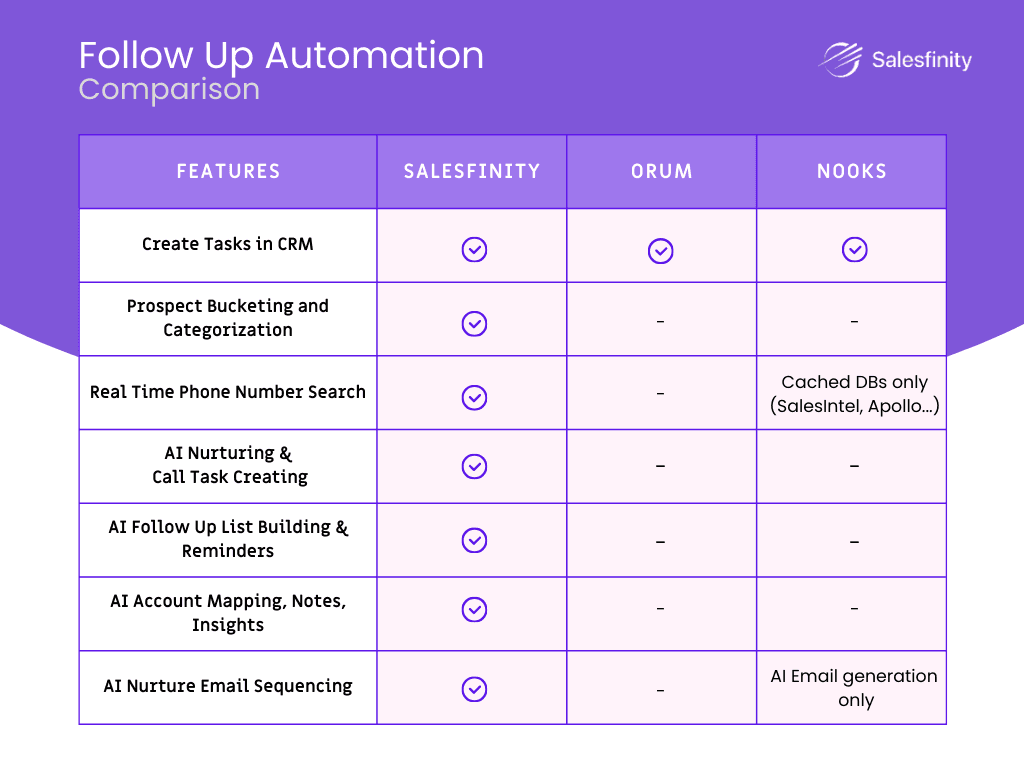
6. The Virtual Salesfloor: Fostering Team Synergy
Collaborative Calling Across Platforms
All three platforms offer a virtual salesfloor, enabling reps to:
Dial Together: Foster camaraderie and healthy competition.
Share Insights: Real-time collaboration boosts team performance.
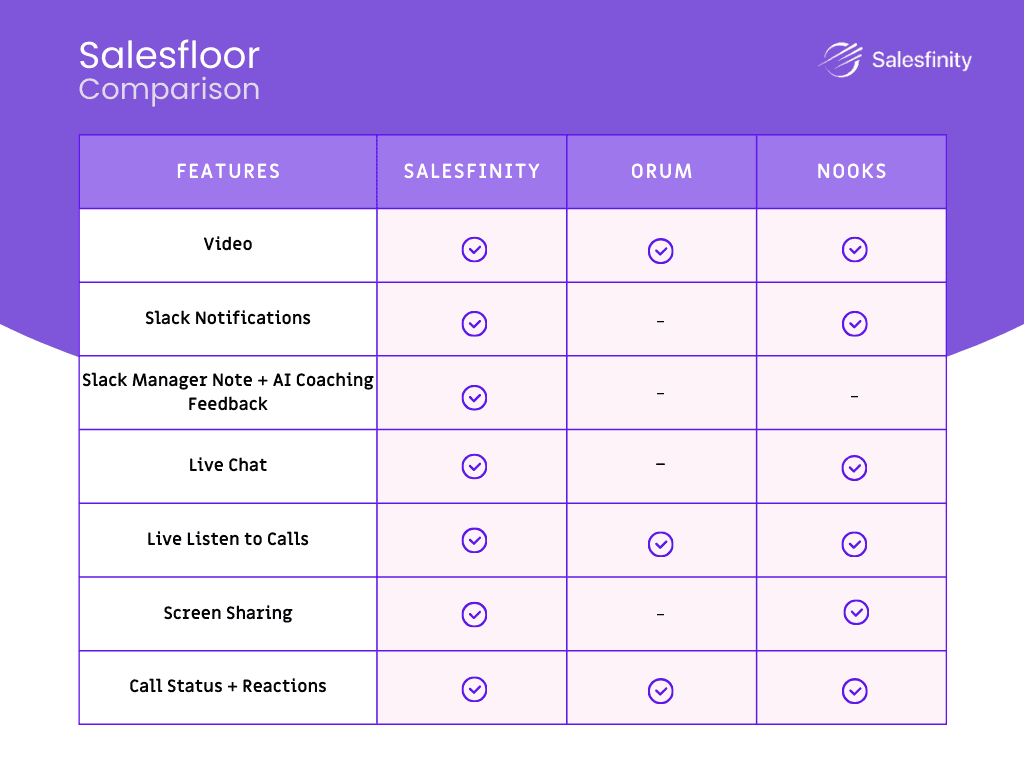
7. Cutting-Edge AI Features: Beyond the Basics
AI Innovations in Orum and Nooks
Both Orum and Nooks offer AI-powered features like call summaries and post-call email generation. These are fantastic tools that save time and streamline workflows.
Salesfinity's AI Powerhouse
Salesfinity doesn't just stop at summaries. It unleashes a suite of AI capabilities that redefine what's possible:
AI SDR: Automatically sequences unresponsive contacts into email campaigns via platforms like Smartlead.ai and Instantly.ai.
AI Auto Snoozing: Set rules to snooze contacts, ensuring you reconnect at optimal times.
AI-Powered Signals: Get real-time insights on company news, hiring trends, financial reports, and more—giving you unparalleled context for your calls.
AI Cold Call Script Writing: Generate customized, high-impact scripts tailored to each prospect.
Open API for AI Integration: Connect with any AI tools or platforms your team uses.
With Salesfinity, AI isn't just a feature—it's the core of an intelligent, dynamic prospecting experience.
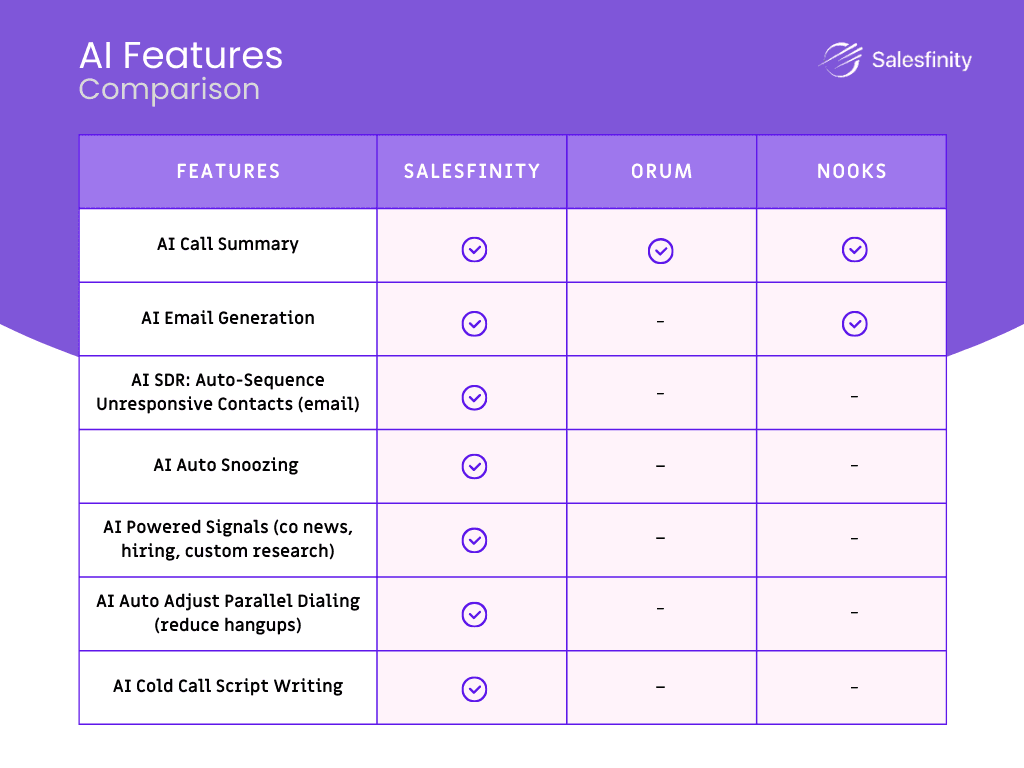
Embracing the Future: Why Salesfinity Stands Above the Rest
Holistic Prospecting vs. Volume Dialing
While Orum and Nooks excel at boosting dial volumes, Salesfinity focuses on compounding results. It's not about making more calls—it's about making smarter ones.
The Compound Prospecting Advantage
By systematically following up and nurturing prospects, your efforts snowball over time:
Sustainable Growth: Each month builds upon the last.
Increased Efficiency: Warm calls replace cold ones.
Higher Conversion Rates: Relationships trump random outreach.
Pricing Transparency: Investing in Success
While Orum and Nooks keep their pricing under wraps, Salesfinity believes in transparency. Pricing starts at $300 per user per month, billed annually. An investment that delivers exponential returns through sustained, intelligent prospecting.
Conclusion: Make the Smart Choice for Your Team
In the relentless arena of B2B SaaS sales, you need more than just a dialer—you need a strategic ally. Orum and Nooks are powerful tools that enhance dialing efficiency. But if you're aiming for long-term, compounded growth and a holistic prospecting approach, Salesfinity is the unrivaled champion.
15 Frequently Asked Questions About Salesfinity vs. Orum vs. Nooks
1. What is a parallel dialer?
A parallel dialer is a sales tool used by SDRs (Sales Development Representatives) to increase call efficiency by dialing multiple prospects simultaneously. It connects the sales rep to the first prospect who answers, allowing for more calls and conversations in less time. This technology is commonly used in cold calling to maximize outreach efforts.
2. How does Salesfinity's parallel dialer differ from Orum and Nooks?
While Orum and Nooks dial multiple prospects (often up to five) at once and connect the rep to the first one who picks up—hanging up on the others—this can lead to frustrated prospects and spam flags from carriers. Salesfinity utilizes a feature called SmartFlow that scores contacts based on their likelihood to pick up. It dynamically adjusts the number of parallel dials, reducing hang-ups and improving connection rates. This smart dialing approach ensures better engagement with prospects and protects your numbers from being marked as spam.
3. Why is Salesfinity better suited for professional B2B SaaS SDR teams?
Salesfinity is designed specifically for professional B2B SaaS SDR teams who aim to achieve more than just increased dial volumes. It focuses on compounding results by enhancing prospecting strategies through features like SmartFlow, AI-driven insights, and comprehensive follow-up automation. This approach not only boosts immediate sales opportunities but also fosters long-term relationships with prospects, leading to sustained success.
4. What are the key features of Salesfinity's AI Dialer?
Salesfinity's AI Dialer offers:
SmartFlow Technology: Intelligent dialing that adjusts parallel calls based on prospect pick-up likelihood.
AI Objection Analysis: Sentence-level analysis of calls to understand objections and effective responses.
AI-Powered Signals: Provides real-time company insights, news, and research to personalize outreach.
Data Enrichment: Best-in-class phone validation and enrichment for accurate prospect information.
Follow-Up Automation: Nurture AI that categorizes prospects and automates personalized follow-ups.
AI Cold Call Script Writing: Generates effective call scripts tailored to each prospect.
5. How does Salesfinity's SmartFlow improve cold calling effectiveness?
SmartFlow enhances cold calling by intelligently scoring prospects on their likelihood to answer. For high-likelihood prospects, it reduces or eliminates parallel dialing to avoid hang-ups, ensuring more meaningful connections. This dynamic approach increases connect rates, minimizes the risk of being flagged as spam, and leads to more successful sales conversations.
6. What integrations does Salesfinity offer compared to Orum and Nooks?
Salesfinity offers extensive CRM integration options, including:
Salesforce
HubSpot
Pipedrive
Monday.com CRM
Salesloft
ActiveCampaign
Amplemarket
It also provides an open API for integration with any system, including modern GTM solutions like Clay.com. In contrast, Orum and Nooks have limited integrations, primarily with Salesforce, Salesloft, Outreach, Apollo, and HubSpot.
7. Can Salesfinity integrate with my CRM system?
Yes, Salesfinity offers CRM integration with major platforms such as Salesforce, HubSpot, Pipedrive, and **Monday.com CRM**. Its open API allows for seamless integration with virtually any CRM system, ensuring that your sales team's data is synchronized and workflows are streamlined.
8. How does Salesfinity's AI objection analysis enhance sales calls?
Salesfinity's AI Objection Analysis provides detailed insights by analyzing calls at the sentence level. It identifies:
Common Objections: Understand what prospects are hesitant about.
Rep Responses: Evaluate how reps handle objections.
Effectiveness Metrics: Determine which responses lead to successful outcomes.
This data helps sales teams refine their strategies, train reps more effectively, and improve call success rates.
9. What is compound prospecting, and how does Salesfinity support it?
Compound Prospecting is a sales strategy that focuses on consistent follow-ups and nurturing relationships rather than one-off interactions. Instead of the "spray and pray" method, it emphasizes building a pipeline that grows over time. Salesfinity supports this through:
Nurture AI: Automatically categorizes prospects after each call.
Automated Follow-Ups: Schedules future calls and tasks.
Personalized Insights: Provides context from previous interactions for tailored outreach.
This approach leads to warmer calls, higher conversion rates, and a sustainable prospecting process.
10. How does the follow-up automation in Salesfinity differ from Orum and Nooks?
Salesfinity's Follow-Up Automation is powered by Nurture AI, which:
Auto-Categorizes Prospects: Based on call outcomes (e.g., Not Now, Meeting Needed).
Schedules Follow-Up Tasks: Sets reminders for reps with relevant insights.
Enhances Personalization: Uses previous call data to inform future interactions.
Orum and Nooks lack this level of automation and AI-driven categorization, offering only basic task creation without the advanced nurturing capabilities that drive compound prospecting.
11. Does Salesfinity offer data enrichment features for better prospecting?
Absolutely. Salesfinity provides superior data enrichment through a waterfall system that includes providers like Leadmagic, Prospeo, RocketReach, and Wiza. It validates phone numbers before dialing, ensuring that reps reach the right prospects with accurate information. This leads to higher connect rates and more effective prospecting compared to Orum and Nooks, which have more limited data enrichment options.
12. How does Salesfinity's AI-powered signals benefit my sales team?
Salesfinity's AI-Powered Signals offer:
Company News: Stay updated on prospect companies.
Hiring Trends: Identify growth opportunities.
Financial Reports: Understand company performance.
AI Research: Gain insights from AI agents analyzing relevant data.
These signals allow your sales team to tailor their approach, demonstrate value, and engage prospects with personalized, timely information—improving the chances of successful conversions.
13. What reporting and analytics capabilities does Salesfinity provide?
Salesfinity offers comprehensive analytics, including:
Call Volume and Performance Metrics: Monitor individual and team performance.
Sequence Breakdown: Analyze the effectiveness of different outreach sequences.
Objection Tagging: Track and categorize common objections.
AI-Driven Insights: Leverage AI to gain deeper understanding of prospect interactions.
Additionally, Salesfinity allows data to be pulled via API, enabling custom reporting and integration with other analytics tools.
14. Does Salesfinity have a virtual salesfloor feature like Orum and Nooks?
Yes, Salesfinity offers a Virtual Salesfloor where reps can dial together in a collaborative environment. This feature fosters team engagement, allows for real-time coaching, and creates a competitive yet supportive atmosphere—similar to what Orum and Nooks provide.
15. What is the pricing for Salesfinity compared to Orum and Nooks?
Salesfinity offers transparent pricing starting at $200 per user per month, billed annually. This includes its full suite of features, from the advanced AI dialer to follow-up automation and data enrichment. Orum and Nooks do not publicly disclose their pricing, but Salesfinity aims to provide superior value by focusing on compounding results, not just increasing dial volumes.
Article written by
Mavlonbek
Make 100 cold calls before 10AM coffee break
